Explore Shigatse - Tibet Travel, Asia
As Tibet’s second-largest city, Shigatse offers a unique blend of historical significance and natural beauty, making it a must-visit for those exploring the region. Shigatse, located in the heart of Tibet, is a fascinating place that fascinates visitors with its rich cultural traditions and breathtaking scenery. Known for its ancient monasteries, vibrant local culture, and proximity to the majestic Himalayas, Shigatse provides a truly immersive experience into Tibetan life. Whether you're a history enthusiast, a cultural explorer, or simply seeking breathtaking views, Shigatse has something to offer.
Population: Approximately 800,000 in 2020.
Economy: Shigatse's economy is driven by agriculture, animal husbandry, and tourism. Key industries include barley farming, yak herding, and the production of traditional Tibetan handicrafts and goods.
Landmarks: Famous for the Tashilhunpo Monastery, Shigatse Dzong, and the Yungdrung Ling Monastery.
Tibet
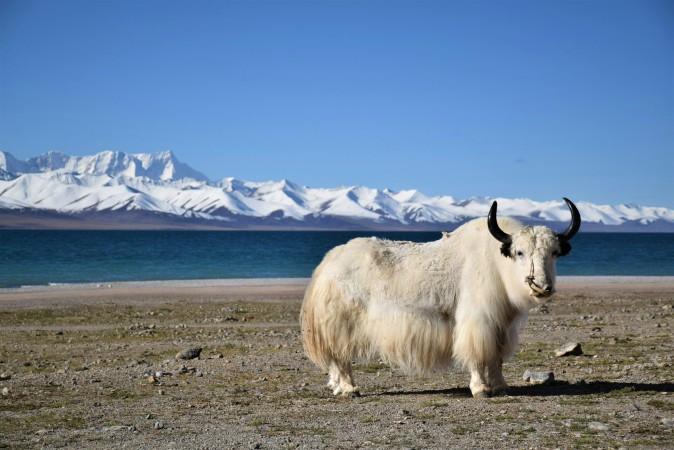
Overview of Shigatse
History & Cultural Influence
Shigatse's history has a strong and unseparated connection to Tibetan culture and religion. As the former seat of the Panchen Lama, Shigatse has long been a spiritual center, home to the revered Tashilhunpo Monastery. Founded in the 15th century by the first Dalai Lama, this monastery stands as a testament to the city's religious heritage and offers visitors a glimpse into the rich traditions of Tibetan Buddhism. The city's history is not only shaped by its monasteries but also by its role in Tibetan politics and trade. Once a key stop on the ancient trade routes connecting Tibet with Central Asia, Shigatse has been a melting pot of cultures and influences for centuries.
Interaction with The Locals
Shigatse, Tibet's second-largest city, has a population of approximately 800,000 residents. The city's population is a vibrant mix of Tibetan ethnic groups, with the majority being Tibetan Buddhists who follow traditional practices and customs. The local population is known for their warmth and hospitality, making visitors feel welcome as they explore the rich cultural and historical tapestry of Shigatse.
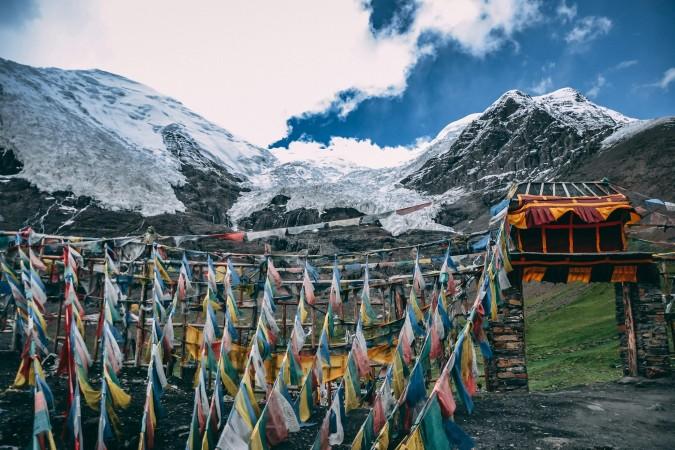
Buddhist Flags outside a monastery in Shigatse - © Daniele Salutari
Top Attractions in Shigatse
Tashilhunpo Monastery
Founded by the first Dalai Lama in 1447, Tashilhunpo Monastery is one of Tibet’s largest and most important monasteries. It serves as the traditional seat of the Panchen Lama, one of the highest-ranking lamas in Tibetan Buddhism. The monastery complex is renowned for its striking architecture, including the vast assembly hall adorned with intricate murals and thangkas (traditional Tibetan scroll paintings).
Shigatse Dzong
Perched on a hill overlooking the city, Shigatse Dzong is a historic fortress that once served as a military stronghold and administrative center. Built in the 15th century, the dzong offers panoramic views of Shigatse and the surrounding landscape. The fortress’s architecture is a blend of Tibetan and Chinese styles, reflecting its strategic importance and the diverse influences on the region.
Mount Everest Views
For those seeking unparalleled natural beauty, the Rongbuk Monastery area, located a few hours from Shigatse, offers breathtaking views of Mount Everest. The monastery, located at an elevation of around 5,000 meters, provides a vantage position for seeing the world's tallest mountain. The journey to Rongbuk is an adventure in itself, taking you through rugged terrain and offering scenic vistas of the Tibetan Plateau.
Yungdrung Ling Monastery
Situated about 20 kilometers from Shigatse, Yungdrung Ling Monastery is an important center of Bon Buddhism, an ancient pre-Buddhist spiritual tradition of Tibet. The monastery, founded in the 10th century, is renowned for its unique Bon religious artifacts and practices. Visitors can explore its intricate murals depicting Bon cosmology, participate in traditional rituals, and learn about the Bon religion’s distinct teachings.
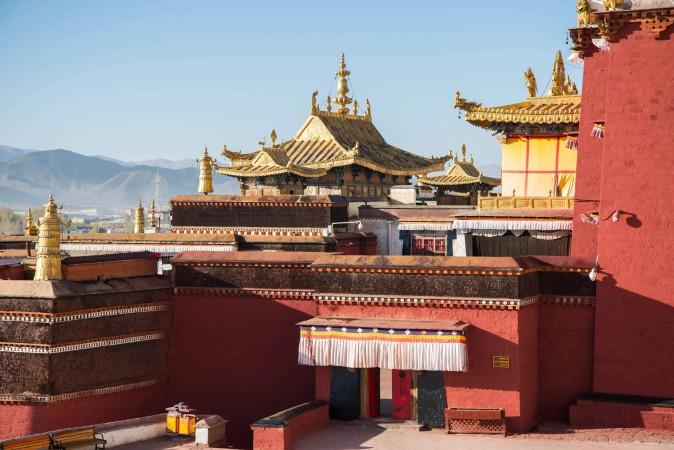
Tashilhunpo Monastery - © Hindustan Times
Must-Try Dishes in Shigatse
Exploring Shigatse is not complete without indulging in its unique culinary delights. Tibetan cuisine offers a variety of flavors that reflect the region's harsh climate and cultural traditions.
- Tsampa: A staple in Tibetan diets, Tsampa is roasted barley flour mixed with butter tea or water to form a dough-like consistency. It's a nutritious and filling dish, often enjoyed for breakfast or as a quick snack during long journeys.
- Momos: These Tibetan dumplings are a popular treat in Shigatse. Filled with minced meat (usually yak or beef) or vegetables, momos are steamed or fried and served with a spicy dipping sauce. They're a must-try for anyone visiting the region.
- Yak Meat: Known for its rich flavor and tender texture, yak meat is a local specialty. It’s commonly prepared as stews, kebabs, or stir-fried dishes. Sampling yak meat dishes provides a true taste of Tibetan cuisine.
- Butter Tea: This traditional Tibetan drink is prepared with tea leaves, yak butter, and salt. It is known for its rich, creamy texture and is considered a symbol of Tibetan hospitality.
- Thukpa: A hearty noodle soup, Thukpa is made with meat or vegetables, and seasoned with Tibetan spices. It's perfect for warming up after a day of exploring Shigatse’s cold, high-altitude environment.
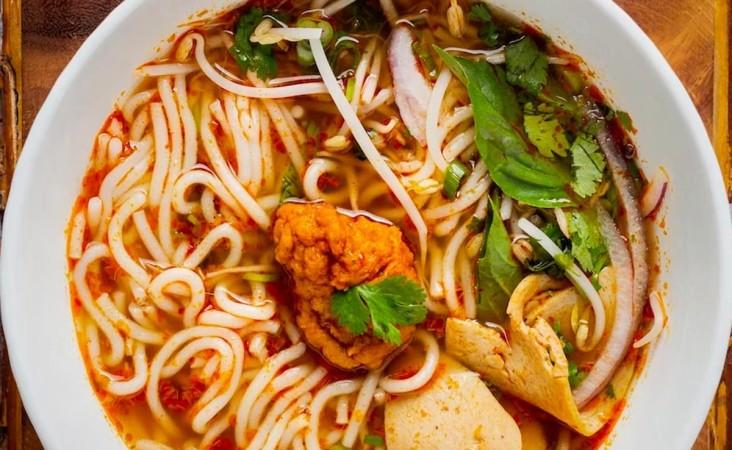
Thukpa - © NDTV Food
Festivals & Local Celebrations
Saga Dawa Festival
Saga Dawa is one of Tibet's most significant religious festivals, celebrated annually in May or June. It commemorates the three major events in the life of the Buddha: his birth, enlightenment, and death. The festival is marked by elaborate ceremonies, including the circumambulation of sacred sites and the offering of prayers. Pilgrims from all over Tibet gather in Shigatse to participate in ritual activities, make offerings, and engage in acts of charity. The streets come alive with vibrant processions, traditional music, and dance performances, creating a deeply spiritual and communal atmosphere.
Shigatse Horse Racing Festival
The Shigatse Horse Racing Festival takes place in August and is a highlight of the Tibetan cultural calendar. This festival celebrates Tibetan equestrian skills with thrilling horse races that attract participants and spectators from across the region. The event features various races, including traditional horse races and local games. In addition to the races, the festival includes colorful parades with traditional costumes, music, and dance performances that showcase Tibetan culture and heritage. It’s a lively and exhilarating event that offers a glimpse into the region’s passion for horsemanship and community spirit.

Saga Dawa Festival - © People's Archive of Rural India
What to Do in Shigatse
- Trekking Mount Everest: The region surrounding Shigatse provides excellent opportunities for trekking and hiking. Trails offer stunning views of the Himalayas and the Tibetan Plateau. Popular trekking routes include those around Mount Everest and the scenic paths near the Rongbuk Monastery.
- Cultural Tours: Guided tours of Shigatse’s historical sites, including the Tashilhunpo Monastery and Shigatse Dzong, offer insights into Tibetan history and religious practices. These tours are ideal for those interested in learning more about the region’s cultural heritage.
- Monastery Tours: Visiting local monasteries such as Tashilhunpo and Yungdrung Ling provides an opportunity to witness Tibetan Buddhist rituals and experience the serene environment of these spiritual centers.
- Explore Local Markets: Shigatse's lively marketplaces provide tourists the opportunity to purchase traditional Tibetan crafts, jewelry, and souvenirs. The markets are also a great place to sample local food and interact with residents.
Shopping in Shigatse
- Traditional Crafts Stores: The city is renowned for its traditional Tibetan crafts, including handwoven carpets, Thangka paintings, and intricate jewelry. These items make for memorable keepsakes and are often available in local markets and specialty shops.
- Shigatse Local Markets: Shigatse’s markets are a hub of activity and offer a variety of goods. The bustling atmosphere provides an authentic shopping experience, with stalls selling everything from Tibetan clothing and textiles to local snacks and spices.
- Souvenir Stores: Visitors can purchase a variety of Tibetan souvenirs, such as prayer flags, traditional masks, and handicrafts. These items are often handcrafted and reflect the region’s cultural heritage.
- Pottery Shops: Local artisans produce beautiful handmade pottery, which is a popular choice for visitors looking to take home a piece of Tibetan artistry.
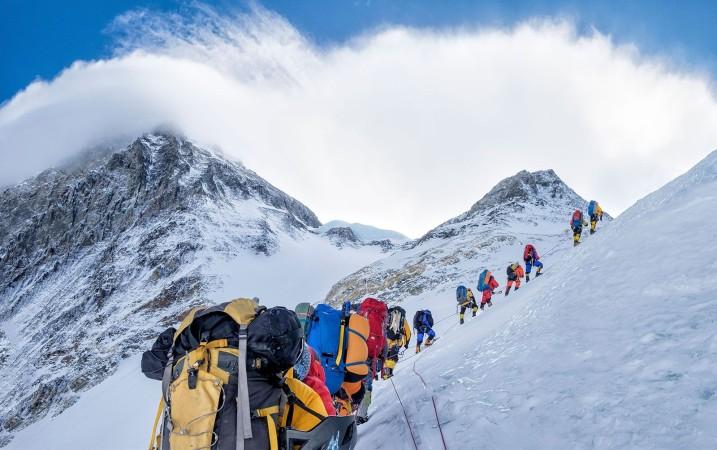
Trekking Mount Everest - © Britannica
Weather in Shigatse: Best Time to Visit
Spring in Shigatse
Spring in Shigatse is a pleasant time to visit, with temperatures ranging from 10°C to 20°C (50°F to 68°F). The weather is generally mild and dry, making it ideal for outdoor activities and exploring historical sites. However, evenings can be chilly, so it's advisable to bring warm layers.
Summer in Shigatse
Summer temperatures in Shigatse typically range from 15°C to 25°C (59°F to 77°F). This is the peak tourist season due to the favorable weather conditions, characterized by clear skies and abundant sunshine. Rainfall is minimal, but occasional thunderstorms can occur. It's a great time for trekking and sightseeing.
Autumn in Shigatse
Autumn brings cooler temperatures, ranging from 5°C to 15°C (41°F to 59°F). The weather is generally dry and crisp, with stunning clear skies and vibrant fall colors. It's an excellent time for photography and outdoor exploration, but temperatures can drop significantly at night.
Winter in Shigatse
Winters in Shigatse are cold, with temperatures often falling below freezing, ranging from -10°C to 5°C (14°F to 41°F). Snow is common, and the city can be covered in a picturesque blanket of white. While winter offers a serene and beautiful landscape, it can be challenging for outdoor activities due to the cold temperatures. Proper winter clothing and preparation are essential if visiting during this season.

Admire the natural beauty along your exploration trail - © ダモ リ(darmau)
Essential Travel Information
Getting Around Shigatse
- Local Buses: Shigatse has a network of local buses that provide affordable transportation within the city. These buses are a convenient option for short distances and exploring various parts of Shigatse.
- Taxis: Taxis are commonly accessible in Shigatse and provide a more pleasant mode of transportation. They are suitable for visitors who prefer a private mode of transport and can be hired for both short trips and day-long excursions.
- Bicycles and Motorbikes: Renting bicycles or motorbikes is a popular way to explore Shigatse and its surroundings at your own pace. This option provides flexibility and the opportunity to enjoy the scenic beauty of the Tibetan Plateau.
ATM & Banking Services
Shigatse provides various ATM and banking services to meet travelers' needs. ATMs are conveniently located throughout the city, especially in central areas and near major hotels, allowing for cash withdrawals in local currency (Tibetan Yuan) with most international bank cards. Banking services are available at multiple banks in the city, offering currency exchange, cash deposits, and account management. While credit cards are accepted in larger establishments like hotels and restaurants, smaller shops and areas away from the city center may require cash transactions.
Where to Stay in Shigatse
- Luxury Hotels: For those seeking high-end comfort and amenities, luxury hotels in Shigatse provide elegant rooms, fine dining, and top-notch services. These accommodations often feature stunning views of the surrounding landscape and offer a range of upscale facilities.
- Mid-Range Hotels: Travelers looking for a balance between comfort and affordability will find several mid-range hotels in Shigatse. These hotels offer clean, well-equipped rooms and convenient amenities, ensuring a pleasant stay without breaking the bank.
- Guesthouses and Hostels: Budget-conscious visitors can choose from guesthouses and hostels that provide basic facilities at an economical price. These options are ideal for travelers who want to save on accommodation while still enjoying a comfortable stay and the opportunity to meet fellow travelers.
- Homestays: For a more immersive experience in Tibetan culture, homestays offer the chance to stay with local families. This option provides a unique insight into daily Tibetan life and traditional hospitality, making it a memorable choice for those looking to connect with the local community.
Articles for you

Explore Yala National Park - Sri Lanka Travel, Asia
Tucked away in Sri Lanka’s southeastern corner, Yala National Park is where wild nature meets deep tradition. Known worldwide for its leopard population, the park is also home to elephants, sloth bears, crocodiles, and hundreds of bird species. Beyond wildlife, Yala opens doors to a cultural landscape dotted with ancient temples, Buddhist ruins, and coastal villages. For travelers seeking more than just a safari, Yala offers a chance to explore eco-tourism, local communities, and sacred heritage sites.
Population: The Yala National Park area doesn’t have a human population.
Economy: The economy around Yala National Park thrives on a blend of eco-tourism, agriculture, and local services. Safari tours, eco-lodges, and cultural experiences drive steady income for nearby towns like Tissamaharama and Kataragama, supporting thousands of families.
Landmarks: Famous for Block I of Yala and wildlife encounters, including elephants, sloth bears, crocodiles, and exotic bird species.

Explore Galle - Sri Lanka Travel, Asia
Nestled on Sri Lanka’s southern coastline, Galle is a vibrant city where history meets the sea. Its cobbled streets, colonial architecture, and serene beaches make it a must-visit destination for travelers seeking a blend of culture, adventure, and relaxation. A UNESCO World Heritage site, Galle captivates visitors with its Dutch Fort, bustling markets, and friendly locals. Whether you’re exploring the ramparts at sunset or savoring fresh seafood by the shore, Galle promises an unforgettable journey into Sri Lanka’s heritage.
Population: Approximately 113,000 in 2023.
Economy: Galle’s economy thrives on tourism, trade, and fisheries. The city’s historic fort, colonial architecture, and coastal charm draw thousands of international visitors each year, making tourism its main economic driver. Fishing remains vital for local livelihoods, supplying fresh seafood across the region.
Landmarks: Famous for the Galle Fort, Dutch Reformed Church & Maritime Museum, and Unawatuna Beach.

Explore Bentota - Sri Lanka Travel, Asia
Nestled along Sri Lanka’s southwestern coast, Bentota is a tropical paradise that blends golden beaches, vibrant culture, and thrilling adventures. Famous for its calm waters, luxury resorts, and scenic river estuary, Bentota has become a top destination for travelers seeking both relaxation and authentic experiences. From serene beach walks at sunrise to adrenaline-pumping water sports, this coastal town offers a perfect balance of leisure and exploration. With its proximity to Colombo and Galle, Bentota is easy to reach, making it an ideal stop for both short escapes and extended holidays.
Population: Approximately 37,000 in 2023.
Economy: Bentota’s economy thrives mainly on tourism, which drives local businesses such as hotels, restaurants, and wellness retreats. The town also benefits from fishing, coconut cultivation, and handicrafts like wood carving and batik textiles. Many residents rely on the growing demand for water sports and Ayurvedic treatments, making tourism the backbone of both income and employment in the area.
Landmarks: Famous for Bentota Beach, Bentota River Safari, and Kande Vihara Temple.

Explore Mirissa - Sri Lanka Travel, Asia
Mirissa is a charming coastal town on Sri Lanka’s southern shoreline. Known for its golden beaches, turquoise waters, and vibrant marine life, it has become a must-visit stop for travelers exploring the island. Many come for whale watching, surfing, and sunset views at Coconut Tree Hill, but Mirissa offers much more than postcard beauty. The fishing boats you see anchored by the bay carry generations of stories. Local traditions, delicious cuisine, and a laid-back rhythm of life shape every visitor’s experience.
Population: Approximately 4,700 in 2023.
Economy: Mirissa’s economy is largely shaped by its coastal location. Fishing has long been the backbone of local livelihoods, with generations relying on the Indian Ocean for income. In recent decades, tourism has become the main driver of growth, thanks to whale watching, surfing, and beachside hospitality.
Landmarks: Famous for Mirissa Beach, Coconut Tree Hill, and Parrot Rock Bridge.

Explore Nuwara Eliya - Sri Lanka Travel, Asia
Tucked away in the Central Highlands of Sri Lanka, Nuwara Eliya is often called “Little England”. With its rolling tea plantations, cool misty mornings, and colonial charm, this mountain town feels like a step into another world. Travelers come here to breathe fresh air, walk through flower gardens, sip the finest Ceylon Tea, and enjoy a pace of life far from the island’s busy cities. Whether you’re drawn by scenic landscapes, heritage architecture, or the warmth of its people, Nuwara Eliya is a destination that blends nature, culture, and history in perfect harmony.
Population: Approximately 781,000 in 2023.
Economy: Nuwara Eliya’s economy thrives mainly on tea production, as it sits in the heart of Sri Lanka’s central highlands, famous worldwide for Ceylon Tea. The city also benefits from a growing tourism industry, attracting visitors with its colonial charm, cool climate, and scenic landscapes.
Landmarks: Famous for Gregory Lake, Hakgala Botanical Garden, and Victoria Park.

Explore Sukau - Malaysia Travel, Asia
Nestled on the banks of the Kinabatangan River in Sabah, Malaysian Borneo, Sukau is a destination where wildlife, culture, and conservation come together. Known as one of Asia’s top spots for river safaris and eco-tourism, this quiet village offers a front-row seat to encounters with Bornean orangutans, pygmy elephants, proboscis monkeys, and exotic birdlife.
Population: Approximately 1,400 in 2019.
Economy: Sukau’s economy is shaped by its riverine location and natural resources. Traditionally, the Orang Sungai community relied on fishing, small-scale farming, and forest gathering for their livelihood. Today, the village has shifted toward eco-tourism, with river cruises, jungle trekking, and homestays providing income.
Landmarks: Famous for the Kinabatangan River cruises, Gomantong Caves, and Ox-bow lakes and wetlands.
